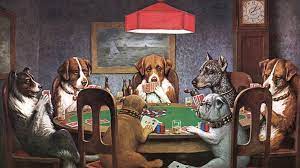Flavor of the month or future of digital IP?
Chances are at some point over the last month you googled NFT. And, if you’re anything like us, the results left you scratching your head and staring up at the ceiling searching for answers. Then, while questioning the meaning of your existence as a creative marketer, you cast your line back into the Great Google Ocean in hopes of catching an answer that is a little more digestible.
Good luck.
A lot of people have explained NFT’s better than we. Blockchain, cryptos, the Ethereum Standard. Just the terminology is enough to wonder if you missed a chapter in your digital commerce handbook. You probably did. And that’s ok because surely it’s out of date already. But we’re not here to decode, we’re simply here to distill and help you be that person who mentions NFTs in a meeting and has just enough talking points to sound like you know what the hell is going on.
Why NFT’s Are Cool
Have you ever wandered through a museum, spotted an original by your favorite artist and thought, “Hot damn, what would it be like to own a thing like that?” Of course you have. And then on the way out you cruise through the gift shop and realize you can get “Dogs Playing Poker” as a print for the same price as an Americano and a cinnamon scone. However, in your heart you know it’s not the same.

Ok, now take that mentality and apply it to digital art. And by digital art we’re talking everything from that snarky go-to gif you share in messenger to the jpeg of fan art depicting a key scene from your favorite Tolkien movie. Yes, those have been copied, screen-grabbed and re-shared a bajillion times online. But the point of NFTs is that embedded within the original is a wee piece of code that travels with it and certifies it as truly original. And because like everything else in our society, art is moving from real to virtual. So it stands to reason that once a piece reaches icon status, people are going to want to claim it.
For collectors of digital paraphernalia, this represents a brave new world of excitement. Imagine being at a cocktail party and being able to say, “Yeah, I own Nyan Cat.” Then imagine spending the next 20 minutes reminding people what Nyan Cat was and how you came to own it. Yes, that’s pretty cool.
Why NFTs Are Not-So-Cool
This could easily turn into an anti-capitalist rant where we express frustration over the need to apply ownership and a monetary value to seemingly everything. But, no. We’re not going that route. Because the truth is that the process of selling NFTs is actually bad for the environment.
Yes, you read that right. The major marketplaces employ a system that keeps a secure record of NFT transactions through the process of mining. This involves a network of computers that turn advanced cryptography into validation of authenticity. The trouble is this process uses a ton of energy. And for those of us looking to be mindful of our carbon footprint, collecting NFTs represents a hobby that results in bragging rights, but at what cost?
The good news is that the marketplaces are wise to this. And they understand that if they are going to continue to exist and grow, they will need to come up with processes that minimize the energy and processing power required to ensure your “Dancing Baby” gif is the genuine article.
So What Does It All Mean?
It’s tough to draw any concrete conclusions on a marketplace that is in its infancy. Because the truth is things could go either way. This might be the flavor-of-the-month tactic that is gone before the start of Q3. OR, someday in the future we may find ourselves in a museum getting emotional as we stand beneath a digital screen extolling the virtues of the original version of Bad Luck Brian.

But what we do know is your boss is going to ask about it. And we need to be prepared to guide them through this murky space. Maybe it’s as simple as asking a few questions. Is it something worth creating to fortify a brand position? Will you get nuked by consumers and the competition for engaging in a behavior that’s not exactly good for the environment? Is what you’re creating worthy of this iconic treatment?
Ok, it’s never that simple. But it’s a start.


